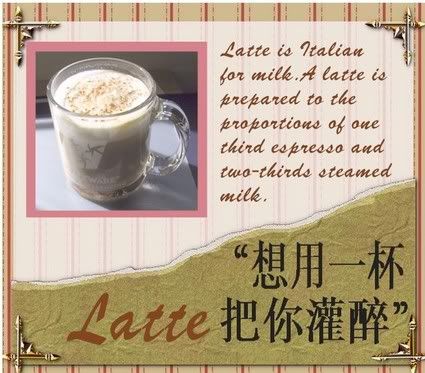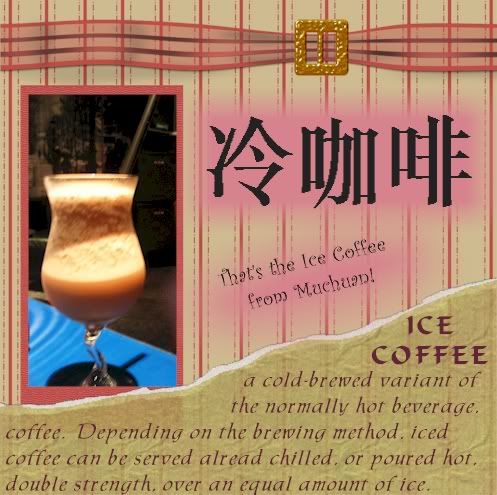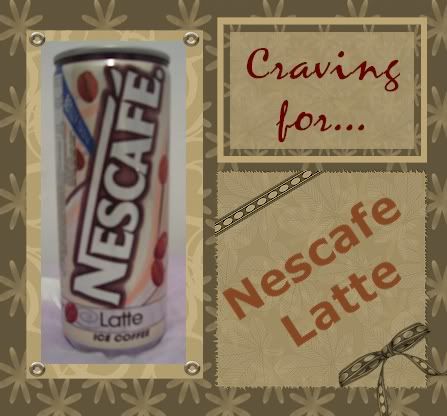Saturday, December 10, 2005
Different Types of Coffee & Digital Scrapbooking
One of the causes which contributes to my "panda eyes" was staying up late to try my hands on
Digital Scrapbooking. I was so excited when I found resources for digital scrapbooking, it simply means I can save $ on doing scrapbook pages. However I do face a lot of limitations, one being I dun have access to Photoshop (or other photo editing softwares)software , and I dun have design background.
Still, I am such a determined (or stubborn) person. Hence I had manage to create the following pages which Image Composer software (it is an outdated software that runs on my home PC's Win 95 operating sytem). With its limited functions, I am contented with the following pages which I managed to create.
To my "professional designer friends" like Ah Shui~s and Flutterby , qing3 duo1 duo1 zhi3 jiao4. (dunno why the chinese software can't work now...).Here are the two pages that provide the defination of Latte and ICE Coffee:


Haha, now u know where I got my source of inspiration from.
And I had broke my record by drinking 4 cans of Nescafe Latte during the past 6 days. That makes me came up with this page:

Even though it had a brown colour scheme, it is still very "my style" right? =P
On a serious note, below are the full definations of Latte, Ice Coffee & Cappuccino which I had extracted from
Wikipedia:
LatteLatte is Italian for milk. In English-speaking countries it usually refers to one of several types of coffee beverages made with hot milk. In Italian these are known as "caffè e latte" (commonly "caffelatte"), literally "coffee and milk", analogous to (but not the same as!) the French "café au lait", and latte macchiato which is very similar.
As the term has come to be used in the United States since approximately 1985, a latte is prepared to the proportions of one third espresso and two-thirds steamed milk. Thus it has more milk than a cappuccino, and has a milder, milkier taste. Lattes should be prepared by pouring milk and coffee simultaneously, from either side of the drinking vessel.
The evolution of this term (and this particular form of the beverage) is relatively recent and probably dates from the spread of the 1980s Seattle coffee craze to the rest of the United States (and beyond) via the growth of Seattle-based Starbucks. Some cafes create designs in the frothed milk.
As recently as 1980, if you ordered a "latte" in an Italian coffeehouse in San Francisco, you would expect to get a glass of milk. If you ordered a "caffè latte," you would get a beverage with far less milk in it than what has now come to be called a "latte." Keep in mind, ordering a "latte" in a café in Italy will result in the barista serving you a plain glass of milk.
In other parts of the world (for example, Australia) lattes are commonly served in a glass (served on a saucer with a napkin which can be used to hold the (sometimes hot) glass). Some baristas will heat the milk to only 65-70C, above which temperature the milk changes in flavour. These beverages are typically made using a 30ml shot of espresso coffee and topped up with frothed or textured milk.
Milk in a latte is often served "frothed", sometimes decorativelyCappuccino(From Wikipedia, the free encyclopedia)
Cappuccino is an Italian beverage, prepared with espresso and milk. A cappuccino is generally defined as 1/3 espresso, 1/3 steamed milk and 1/3 frothed milk. Another definition would call for 1/3 espresso and 2/3 microfoam. A cappuccino differs from a latte macchiato, which is mostly milk and little foam. (A "dry cappuccino" has less milk.)
In Italy it is consumed almost exclusively early in the day for breakfast; in some other countries it may be consumed throughout the day or after dinner.
Besides a quality shot of espresso, the most important element in preparing a cappuccino is the texture and temperature of the milk. When a well-trained barista steams the milk for a cappuccino, he or she should create "microfoam" by introducing very tiny bubbles of air into the milk. This gives the milk an extremely velvety texture and sweet taste.
A cappuccino is ideally prepared in a ceramic coffee cup, which has far better heat retention characteristics than glass or paper.
In some places, skilled baristas create latte art when pouring properly steamed milk into the espresso, making designs such as apples, hearts, leaves and rosettes.
Cappuccino was a taste largely confined to Europe and a few of the more cosmopolitan cities of North America until the mid-1990s when cappuccino was made much more widely available to North Americans, as part of the new upscale coffee bar chains with a consciously "European" air (notably Starbucks). Iced coffee (From Wikipedia, the free encyclopedia)
Iced coffee is a cold-brewed variant of the normally hot beverage, coffee.
Iced coffee usually refers to a specific process of brewing coffee, using cold water rather than hot. Iced coffee is synonymous with the term Toddy coffee, which is a brewing system that was developed and patented by Todd Simpson in 1964 as the first patented cold brewing system. The basic method of brewing cold coffee, whether by the actual Toddy system or a personalized setup involves nearly the same process. The process requires grinding coffee beans at a coarse setting and soaking those grounds in cold water for a prolonged period of time (usually 12 hours or more). The grounds must be filtered out of the cold water after they have been steeped for this period of time, therefore, the grounds can either be put in a bag like filter before steeping or, similar to the Toddy system, the mixture can be fed through a filter after soaking. The end result produces a concentrate that is often diluted with water (or milk in some beverages). Pouring hot coffee over ice often waters down the beverage, while pouring cold brew over ice does not. Toddy Products claims brewing coffee by their method reduces the acidity of the beverage.
This, however, is not the method with which most commercially sold iced coffee is made. Often, it is made by brewing hot coffee at double strength, then pouring over an equal amount of ice or cold water.
Sadly, most iced coffee that is for sale at chain cafes across america is day-old coffee that has sat in the fridge overnight.
Serving
Depending on the brewing method, iced coffee can be served alread chilled, or poured hot, double strength, over an equal amount of ice. Because sugar does not dissolve readily into cold liquids, it must be added either directly to the hot base, or to the finished product in the form of simple syrup, which can be made by mixing quantities of water and sugar, then simmering over low heat until the desired viscosity is attained. Instead of sugar, most synthetic substitutes such as aspartame (Equal, Nutrasweet) or sucralose (Splenda) will dissolve readily into cold coffee.
|


 ~*Harmonie's Sentimental World --心情日记*~
~*Harmonie's Sentimental World --心情日记*~ 
 ~*Harmonie's Sentimental World --心情日记*~
~*Harmonie's Sentimental World --心情日记*~ 







